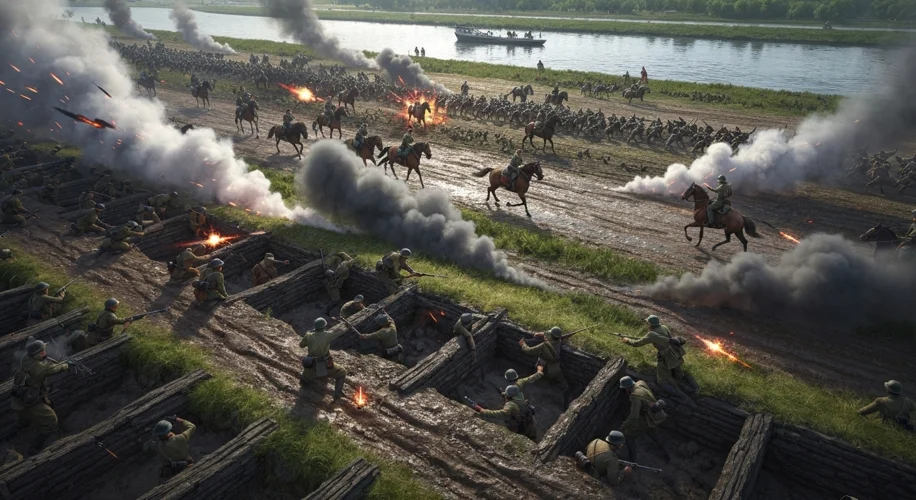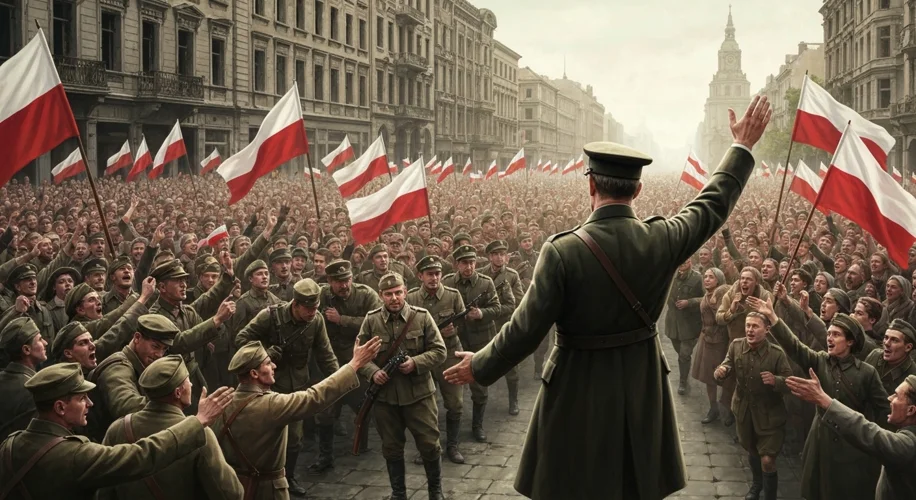The summer of 1920 crackled with an almost palpable tension across Eastern Europe. The Bolshevik Revolution, a whirlwind of radical ideology and bloody upheaval, had unleashed its fervent forces westward. Riding a wave of revolutionary fervor, the Soviet Russian Red Army, under the command of Mikhail Tukhachevsky, surged towards Poland with a singular, terrifying objective: to export the communist revolution to the heart of Europe. But on the banks of the Vistula River, a desperate and determined nation stood in their path, ready to defy the seemingly unstoppable tide.
The newly reborn Polish state, having only regained its independence in 1918 after over a century of partition, found itself on the precipice of annihilation. The Polish-Soviet War, a brutal and complex conflict born from the ashes of World War I and the redrawing of European borders, had reached its zenith. Poland, a patchwork of historical territories and diverse populations, was a bulwark against the Soviet advance, a nation fighting not just for its own survival, but for the future of the continent.
At the heart of this titanic struggle was a clash of ideologies as much as a clash of armies. The Bolsheviks, fueled by the promise of a global proletarian revolution, saw Poland as a crucial stepping stone. Their propaganda painted a vivid picture of liberation, promising an end to oppression and the dawn of a new socialist era. For the Soviets, the capture of Warsaw would be a symbolic victory, a powerful demonstration of their ideology’s irresistible march.
Conversely, Poland, under the leadership of Marshal Józef Piłsudski, a seasoned military leader and statesman who had fought for Polish independence for decades, was determined to preserve its hard-won sovereignty. Piłsudski, a shrewd strategist, understood the immense stakes. He envisioned a Poland that was not merely a nation-state, but a federation of Eastern European nations, a powerful counterweight to both Russian and German ambitions. The Red Army’s advance threatened to crush this vision before it could truly take root.

The summer months saw the Red Army push deep into Polish territory. By early August, Warsaw, the Polish capital, was encircled. The air was thick with the acrid smell of gunpowder and the desperate prayers of a nation under siege. Tukhachevsky, confident of victory, planned a pincer movement, aiming to crush the Polish defenses and march into Germany. The fate of Poland, and potentially much of Europe, hung precariously in the balance.
However, what Tukhachevsky underestimated was the spirit of the Polish soldier and the strategic genius of Piłsudski. In a daring and audacious move, Piłsudski conceived a counter-offensive, a bold gamble that would come to be known as the “Miracle on the Vistula.” While the bulk of the Red Army was focused on attacking Warsaw from the west, Piłsudski secretly moved a significant portion of his forces, including his elite Third Army, northwards. Their mission: to strike the exposed Soviet flank and rear, severing their supply lines and throwing their advance into disarray.
The critical phase of the battle unfolded between August 13th and 16th, 1920. The fighting was ferocious. Polish Uhlans, cavalry soldiers wielding lances, charged against Soviet infantry and artillery, their bravery a stark contrast to the Soviet’s often ill-equipped and ideologically driven troops. The Red Army, caught completely by surprise by Piłsudski’s flanking maneuver, found itself in a desperate fight for survival. The Polish offensive was ruthlessly effective, smashing into the Soviet Ninth Army and encircling large parts of it.

The impact of the Polish victory was nothing short of staggering. The Red Army, which had seemed on the verge of conquering Eastern Europe, was routed. Thousands of Soviet soldiers were killed or captured, and their westward advance was decisively halted. The “Miracle on the Vistula” was not just a military triumph; it was a geopolitical turning point.
The consequences rippled across the continent. Bolshevism, which had threatened to engulf Europe, was contained. Poland secured its independence and its borders, albeit through a bloody and costly conflict. The victory bolstered Polish national pride and cemented Piłsudski’s reputation as a national hero. It also allowed for the continued existence of independent states in Eastern Europe, preventing the immediate imposition of Soviet rule on nations like Ukraine and Belarus, who had been fighting alongside Poland.

Historians continue to debate the precise factors that contributed to this momentous victory. Some emphasize Piłsudski’s brilliant strategic planning and the psychological impact of the surprise attack. Others highlight the crucial role of intercepted Soviet radio communications, which provided Polish intelligence with vital information about Tukhachevsky’s plans. The fierce determination of the Polish soldiers, fighting for their homeland, cannot be overstated. Many historians also point to the inspirational role of religious faith, with prayers offered in churches and chapels across Poland, contributing to the narrative of divine intervention that gave the battle its famous moniker.
Ultimately, the Battle of Warsaw stands as a testament to the power of courage, strategic acumen, and national resilience. It was a moment when a young, embattled nation, armed with a fierce love for its freedom, stood against an ideological juggernaut and emerged victorious, altering the course of 20th-century history and safeguarding Europe from a Bolshevik conquest that might have irrevocably reshaped its destiny.

